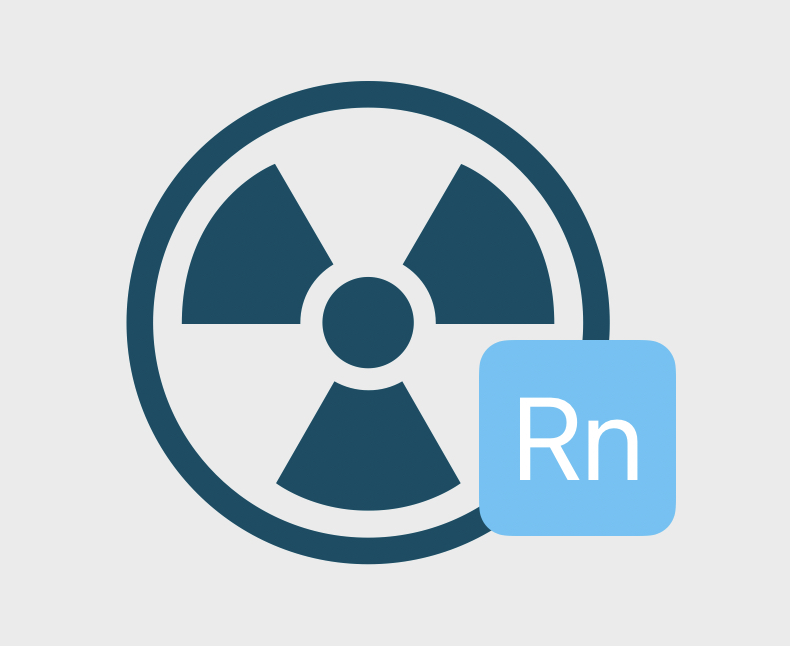Why Test for Radon?
Radon is a naturally occurring radioactive gas and can seep through buildings and houses when released from the surrounding soil. Exposure to high concentration of radon poses serious health risks to the residents. Radon is carcinogenic and is one of the leading causes of lung cancer. Being odorless, colorless, and tasteless, radon testing is the only way to be sure if the levels of radon present in your home is within the safety limit.
When to Test for Radon?
The levels of radon is unpredictable and can fluctuate all the time. EPA recommends all homes to be tested for radon for every two years to help mitigate any potential health risks due to high radon exposure.
You may also want to test for radon if you:
– Recently finished a basement or other lower level areas.
– Recently remodeled the house.
What We Offer

We are PA-DEP certified radon professionals.

A minimum of 48 hours radon measurement using Continuous Radon Monitoring Device is included for more accurate radon testing.

Radon testing will be conducted typically in the lowest level area, as outlined in AARST-NRPP standards.

We deliver test report that is compliant with the PA-DEP requirements.
Radon Testing Home Inspections
Radon is a naturally occurring radioactive gas resulting from the decay of uranium in soil, rock, and water. This invisible, odorless, and tasteless gas can build up in homes and buildings, presenting a significant health hazard to residents. In fact, radon exposure is recognised as the second leading cause of lung cancer in the United States, contributing to over 20,000 deaths each year.
To safeguard your family’s health from radon-related risks, conducting a radon test in your home is crucial. A radon inspection measures the concentration of radon gas within a property. Various radon testing techniques exist, ranging from short-term (two to seven days) to long-term (over 90 days) assessments.
Conducting a radon inspection is a vital measure for maintaining your family’s safety and well-being. By testing for home’s air quality, you can determine the presence of elevated home’s radon levels and implement appropriate mitigation measures. This guide will delve into radon inspection details, covering radon basics, testing approaches, result interpretation, mitigation options, the role of home inspections, how radon infiltrates buildings, legal considerations, and answers to common questions.
Key Takeaways
- Radon is a radioactive gas that can accumulate in homes and buildings, posing a health risk to occupants.
- Home radon tests involves measuring the levels of radon gas in your home to identify if there are any high levels of radon gas present.
- Radon home inspection is an important step in ensuring the safety and health of your family.
Home Inspection and Radon Tests
When it comes to buying a new home, a radon inspection is an important safety measure that should not be overlooked. Our home inspectors from AO-HomeInspections.com are trained to look for signs of high radon during a home inspection. In this section, we will discuss what home inspectors look for during a radon inspection, and how to deal with high level of radon in real estate transactions.
What Home Inspectors Look For
During a home inspection, a home inspector will typically use a radon testing kit to determine if there are high levels of radon in the home. The inspector will place the testing kit in the lowest level of the home, such as the basement or crawl space, where radon test are typically the highest. The kit will remain in place for a period of time, usually between 48 hours to a week, to collect air samples.
If the radon test results are found to be high, the inspector will recommend further testing or mitigation measures.
Dealing with High Radon Levels in Real Estate Transactions
If high levels of radon are found during a home inspection, it is important to take action to protect the health of the home’s occupants. Home buyers may negotiate with the seller to reduce radon before completing the sale. Alternatively, they may withdraw from the sale if radon is too high and the seller refuses to address it.
Homeowners who have already purchased a home and later discover high levels of radon may also take steps to mitigate the issue. This can include installing a radon mitigation system, which can reduce radon levels by up to 99%.
Understanding and managing your home’s radon levels is vital for your well-being. At AO Home Inspections, we specialize in conducting thorough radon inspections to give you clarity and peace of mind. With our certified inspectors by your side, you’ll receive expert assessments and tailored recommendations. Call us at +1(215)313-7499 to find out more about how we can help safeguard your home.
Radon Entry Points and Building Dynamics
Radon is a radioactive gas that naturally occurs in soil and rock. It can seep into homes through cracks and gaps in the foundation, walls, and floors. Radon can also enter through crawl spaces, vents, and other openings in the building envelope. Since radon is odorless and colorless, it can be difficult to detect without proper testing. In this section, we will discuss common entry points for radon and building features that can influence radon levels.
Common Entry Points for Radon Gas
Radon gas can infiltrate homes through several entry points, mainly through soil, foundation cracks, wall gaps, building envelope openings, unsealed crawl spaces, and improperly sealed vents. The level of radon entry depends on soil radon concentration, soil permeability, construction quality, and the sealing of gaps and vents.
Building Features Influencing Radon Levels
Several factors related to building design can impact radon concentrations within a home, including:
- Radon Mitigation Systems: Utilizing suction through a radon mitigation system can effectively lower radon levels. This system employs a fan to extract radon gas from the property and discharge it externally.
- Foundation Design: The foundation type of a home affects its vulnerability to radon. Homes with basements or crawl spaces tend to have higher radon levels compared to those built directly on concrete slabs.
- Construction Materials: The materials used in home construction can also dictate radon infiltration. Homes constructed with more porous materials, such as concrete blocks or hollow bricks, are more susceptible to radon entry than those built with denser materials like solid concrete.
- Home Ventilation: Enhancing ventilation within a home can assist in lowering radon levels. Strategies include opening windows, using exhaust fans, or installing a heat recovery ventilator to promote air exchange.
In summary, the entry of radon into homes can be influenced by various building aspects and features. It’s important for homeowners to recognise these elements and implement suitable testing and mitigation strategies to manage indoor radon levels effectively.
Radon Testing Methods
When it comes to testing for radon in a home, there are three primary methods to consider: short-term radon tests, long-term radon tests, and continuous radon monitors. Each method has its own advantages and disadvantages, so it’s important to choose the right one for your specific needs.
Interpreting Test Results
After conducting a radon test in a home, it is important to understand the results to determine if any action is necessary. This section will cover the two main aspects of interpreting radon test results: understanding radon levels and when to take action.
Understanding Radon Levels
Radon levels are measured in picocuries per liter (pCi/L). The EPA has set the action level at 4.0 pCi/L or higher. If the test result is at or above this level, it is recommended to take action to reduce radon levels in the home.
It is important to note that the higher the radon level, the greater the risk of lung cancer. According to Dupage Radon, radon levels greater than or equal to 4.0 pCi/L put individuals at an unusually high risk for lung damage and cancer.
Legal and Regulatory Considerations
Radon is a radioactive gas that can cause lung cancer. As a result, many states and the federal government have developed laws and regulations governing radon disclosure, radon certification, and mitigation. Homeowners and homebuyers should be aware of these laws and regulations to protect themselves from radon exposure.
State and Federal Radon Laws
The Environmental Protection Agency (EPA) recommends that all homes be tested for radon. Some states have developed mandatory radon testing provisions in schools and homes in certain contexts. For example, in Illinois, all schools are required to test for radon every five years. In addition, some states require radon disclosure in real estate transactions. For example, in Illinois, the Radon Awareness Act requires all home sellers to provide a radon disclosure form to all buyers.
In addition to state laws, the federal government has developed regulations governing radon. The EPA has established a Radon Program that provides guidance on radon testing, mitigation, and radon-resistant new construction. The EPA also maintains a map of radon zones that identifies areas of the country with high levels of radon.
Radon Disclosure in Real Estate
Many states require radon disclosure in real estate transactions. In Illinois, for example, all home sellers are required to provide a radon disclosure form to all buyers. The form must include information about the health risks of radon, as well as the results of any radon testing that has been conducted on the property.
Homebuyers should be aware of these laws and regulations when purchasing a home. They should ask their real estate agent if the home has been tested for radon and if the results of the test are available. If the home has not been tested, the buyer should request that a test be conducted before closing. If the radon level is 4 picocuries per liter (pCi/L) or higher, the buyer should request that the seller fix the home.
In conclusion, homeowners and homebuyers should be aware of state and federal radon laws and regulations. They should take steps to protect themselves from radon exposure, including testing their homes for radon and fixing any radon problems that are found.
Radon testing is a critical aspect of maintaining a healthy living space. If you’re looking for expert insights into your home’s air quality, AO Home Inspections is ready to assist. With a decade of experience in the field, our certified inspectors offer thorough evaluations and practical solutions. Contact us at (215)313-7499 to discuss how we can support your home’s safety without any obligation.”
Frequently Asked Questions
What does a radon inspection entail?
A radon inspection involves testing the air in a home to determine the level of radon gas present. The inspector will typically use a device that measures the concentration of radon in the air over a period of time, usually between two and seven days. The inspector will place the device in the lowest level of the home that is regularly used, such as a basement or living room. After the testing period, the inspector will collect the device and analyze the results to determine the level of radon gas in the home.
How long does a radon test take during a home inspection?
A radon test typically takes between two and seven days to complete, depending on the type of test being used. Short-term tests are usually conducted over a period of two to four days, while long-term tests can take up to three months to complete. During this time, the testing device will be left in the home to collect data on the level of radon gas present.
Are there specific requirements for radon inspections in homes?
The requirements for radon inspections vary depending on the state and local regulations. Some states require radon testing as part of the home inspection process, while others do not. It is important to check with the local authorities to determine the specific requirements for radon testing in a particular area.
What are the typical costs associated with a radon inspection?
The cost of a radon inspection can vary depending on the location, the type of test being used, and the qualifications of the inspector. According to Bob Vila, most radon inspection costs range from $146 to $716, with a typical average of $420.



